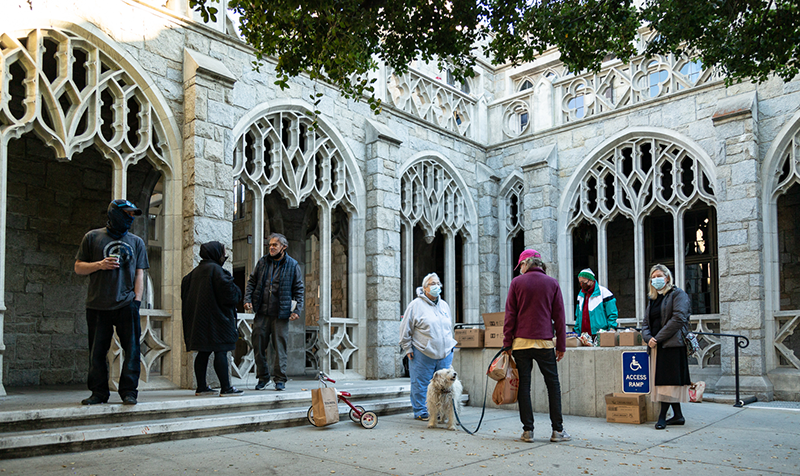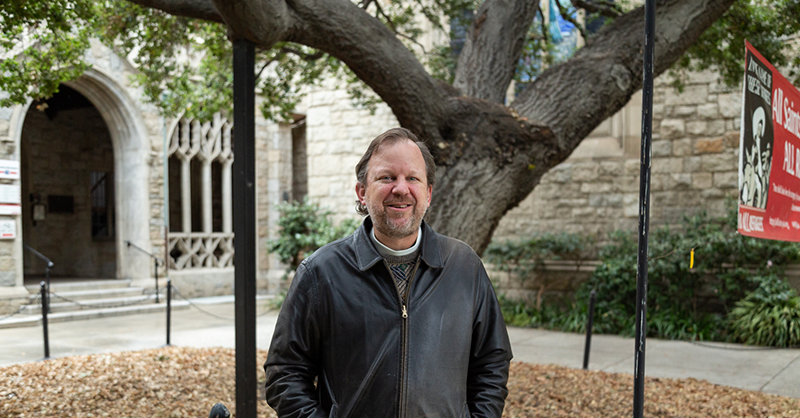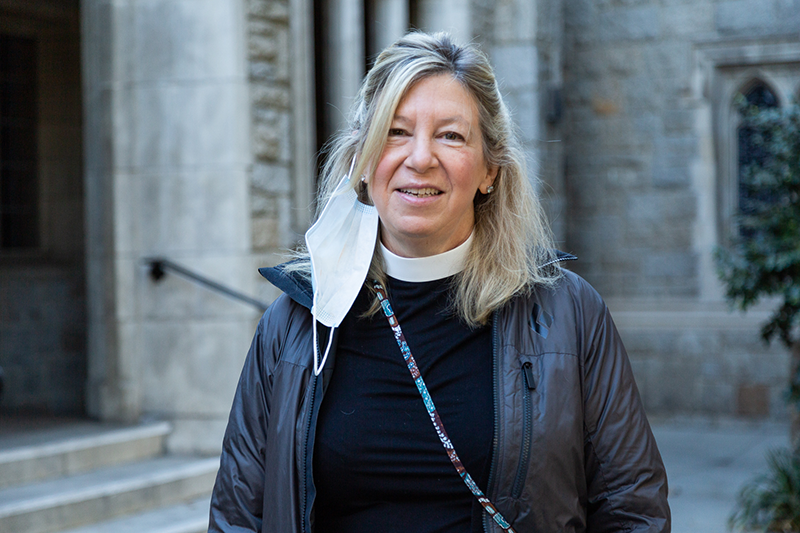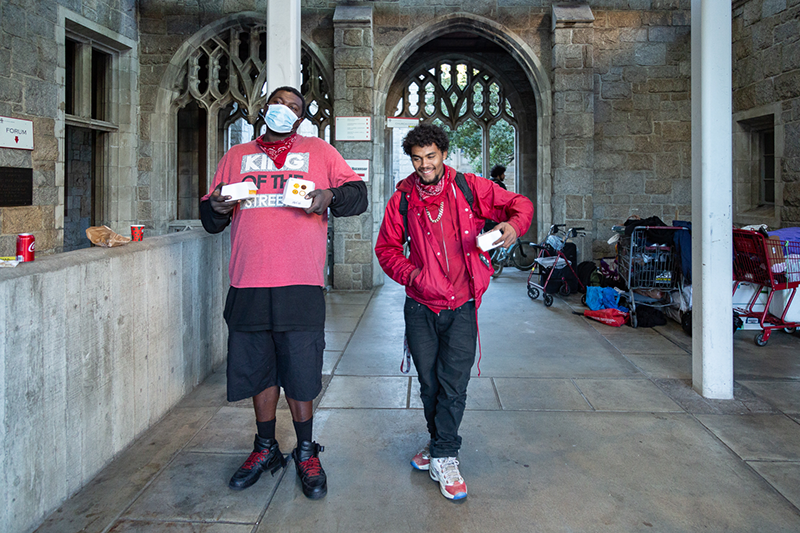Marcy Dyment arrived for Christmas Day breakfast at All Saints Episcopal Church on a peaceful, convivial kind of morning in Pasadena, California.
With her dog, Bullet, in tow, the 57-year-old former elementary school teacher chatted with parish leadership and about a dozen unhoused people from the church’s Safe Haven Bridge to Housing program.
She and the other people gathered there were treated to packaged McDonald’s meals, lined up on socially distanced tables in accordance with coronavirus protocols.
It was a reunion of sorts for Dyment, who had moved into permanent housing in December after three years of living on the streets. Dyment said she is grateful for the effort the church is making at a difficult and complicated time in a situation that is often messy and imperfect.
“They’re just extremely tolerant, wonderful people,” she said.

Dyment is just one of the now-housed folks who have been helped by All Saints’ Safe Haven Bridge to Housing, a ministry of the church launched in October 2020.
Although a small number of unhoused people have lived on the All Saints campus for years, the church was overwhelmed with people needing shelter during the early days of the pandemic when local facilities cut capacity and nearby City Hall closed.
Through trial and error, planning and reaching out to community partners, All Saints has worked to create a manageable system in which 12 people without shelter can stay on church grounds and receive support services.
Church leaders hope to expand this model to other congregations to create a network of support for the unhoused without overly taxing any one church.
It’s particularly important to them that the model be workable for smaller and less wealthy congregations than the 3,000-member All Saints, said the Rev. Mike Kinman, the church’s rector.
The process has not been easy, and All Saints leadership has had to pivot. But they are clear that it’s been worth it -- not just because of what the church can now offer people who lack housing but also because of the community it has nurtured.

For Kinman, the social connection has been vital during the pandemic, when the church building has been empty. Just hanging out and talking with the folks living on the campus has kept him going, he said.
“Their time was and remains such a gift to me,” he said. “It has given me such life. This is what is keeping me sane. This is what is keeping me grounded -- mentally, emotionally, spiritually.”
In what ways does or could your church’s community include those who are not members? How might that benefit your congregation?
That sense of community is invaluable -- not just for church staff but also for the folks living outside, said Anne Miskey, the CEO of Union Station Homeless Services, which has been working with All Saints.
“What is so spectacular, if that is the word I can use,” Miskey said, “is that we are … working with a congregation, a community, that has embraced these people as a part of their community. That is a huge aspect in people’s journey. … That just enhances everything.”
A small beginning
Located in Pasadena’s Civic Center District -- with includes City Hall, the courthouse and the police station -- the All Saints campus features a lush, tree-lined courtyard surrounded by the church and other buildings that have long been havens for those seeking shelter from rain and harsh weather.
When City Hall began moving people off its property at night several years ago, All Saints beefed up its security and let people sleep on its campus between 10 p.m. and 6 a.m. in designated spaces. People were directed away from high-voltage areas and hidden places that could be assault risks, particularly for women.

Dyment, formerly a resident of suburban South Pasadena, was among the regulars of All Saints’ unhoused community that slept outside in sleeping bags on the church grounds, usually six to a dozen people at any given time. For a year, she sought refuge there at night, gradually getting to know the church staff.
Then the pandemic hit.
In an effort to slow the virus’s spread, Gov. Gavin Newsom ordered churches and other businesses closed. Shelters were restricted to 25% capacity, and day centers, libraries and other public spaces where unhoused people would normally go were shut down.
A one-day count of the homeless population conducted before the pandemic in January 2020 found 527 people experiencing homelessness in Pasadena. In Los Angeles County, in which Pasadena is located, the count was 66,436, a rise of 12.7% from the previous year.
After the pandemic hit, unhoused people had nowhere to go in the day and nowhere to sleep at night. The response from the city was sluggish, Kinman said, and word spread through the encampment communities that All Saints was the place to be.
“Everyone was in this mode of how to adjust to doing everything online and stuff like this, and with everyone sort of in this crisis mode -- other than the nonprofits who are generally working with people experiencing homelessness, who are also in a crisis mode -- no one’s doing anything,” he said.
All Saints wanted to be part of a long-term solution, getting people into housing and building community support to keep them permanently housed.
Gloria Antall, an All Saints member since 2010 and co-chair of the Safe Haven Bridge to Housing project, said the housing effort was a natural fit for the church.
“If you believe in spiritual signs from God, it was the most obvious one. This was just the [work] that literally fell into our lap, and we just picked it up and carried it along.”
Is there anything that has fallen into your lap as an organization that you might respond to?
In keeping with its commitment to social justice, the congregation wanted to continue to welcome folks in need. In the church’s courtyard is a bright red banner declaring, “All Saints Welcomes ALL Refugees.”
Although that was erected in 2018 to remind the congregation of its rich history as a sanctuary church, Kinman sees a connection to the church’s current situation.
“It just happened to be the banner that was up when we were shut down for COVID,” Kinman said. “When people started coming in, it became anyone seeking refuge.
“That’s what people are doing here: seeking refuge.”

A turning point
After a few months, though, it became clear that good intentions weren’t going to be enough to make this work sustainable. Something needed to change.
By June, there were 60 encampments on the grounds. And despite efforts such as bringing in portable toilets and wash stations and establishing rules of conduct, the situation had become untenable.
“It just became a free-for-all regarding drugs, prostitution, stolen bicycles,” Dyment said. “It was no longer a safe haven. It became a refuge for illegal activity.”
How would you have handled this situation? How do you decide when to pivot and when to declare an initiative a failure?
The situation had also become a concern for others. Residents of the nearby Maryland Apartments began complaining to the pastor about late-night noise, among other issues.
Parishioners driving by their now-closed church were appalled by the messiness of their beloved campus, and were vocal about their displeasure.
Members of the parish often inquired about increasing security, but the church couldn’t afford a 24-hour presence, and Kinman objected to that approach on principle.
“We really don’t want to do it that way,” he said. “When you have security around all the time, it creates an oppositional relationship, and people do not feel like part of the community.”
Reaching out to new partners
In the meantime, All Saints was working with local service providers, including Union Station Homeless Services, which had begun at All Saints in the 1970s providing meals for poor and homeless men. The church also sought help from First United Methodist Church of Pasadena, which had been working with unhoused folks as well.
“Frankly, my experience with churches is that we can be some of the absolute worst social service providers,” Kinman said. “We are huge on heart and good intentions and -- a lot of times -- low on expertise.
“So we went to Union Station and said, ‘We have this community here; let’s talk about what love looks like.’”
Where could you find partners to help you grapple with your most difficult and complex problems?
During that period, medical teams from Keck Medicine of USC and the county came to provide medical screenings and COVID testing; church leaders also educated folks on mask wearing.
With help from Union Station, First United Methodist and a social care-based program of the Pasadena Police Department, All Saints developed Safe Haven Bridge to Housing.
It’s a volunteer-run program headed by co-chairs Erica Tamblyn and Gloria Antall under the auspices of the parish’s Community Care team, which is led by the Rev. Dr. Sally Howard, associate rector.

Safe Haven Bridge to Housing uses the “housing first” approach, in which participants are not required to meet certain criteria, such as obtaining a job or addressing substance abuse, before gaining access to housing.
With the Safe Haven program in place, the situation became more manageable as the church now provided services and support and not just a place to sleep.
By October, the church had set a limit of 12 on the number of residents on the grounds, with each assigned a social worker. They issued identification cards to the participants and moved the sleeping area to the less-public inner courtyard.
Safe Haven residents are allowed to sleep overnight in designated spaces only, and all belongings except a backpack must be stored in a locker after 7 a.m. (The lockers were purchased with a $25,000 grant from the Pasadena Community Foundation, along with a $25,000 gift from a non-parishioner.)

Participants must abide by an 18-point covenant, which stipulates no violence, no weapons, no smoking, and no drug use or selling of drugs on the campus property. The community is self-policing, in conjunction with a hired security service.
With All Saints as their permanent address, the Safe Haven Bridge to Housing participants can now more easily receive Social Security benefits, workers’ compensation checks and other necessary aid.
For folks not accepted into the program, Union Station has agreed to stay in touch so that caseworkers can help them find places for refuge, medical care and -- it is hoped -- permanent housing.
So far, four people have found permanent homes through the program.
Everyone involved with Safe Haven Bridge to Housing, from the staff to participants such as Dyment, acknowledges that the program is still a work in progress.
For her part, Dyment is grateful for the effort the church is making at a difficult and complicated time in a situation that is often messy and imperfect.
“There’s a balance between tolerance of behavior and providing a safe place to sleep -- and I think the church is actively working on that right now,” she said.

Post-pandemic plans
Although intensified by the pandemic, homelessness is an ongoing problem, and All Saints hopes to continue to expand the Safe Haven Bridge to Housing program.
“Homelessness, especially in Los Angeles, is in your face everywhere you go. It’s on the streets; it’s on the corners; it’s under freeway overpasses, people begging in the streets. And our hearts here at All Saints bleed when we see that,” said Tamblyn, the Safe Haven co-chair.
The congregation recognizes the “institutional racism, institutional misogyny, institutional economic racism” behind the current crisis, said Antall, the other co-chair.
“It’s not their fault, in many cases, that they ended up where they ended up. Through some institutional decision, they’ve been put out on the streets. So as a church that believes in that, this is the outward expression of that problem. It fits with our church’s mission,” she said.
Currently, All Saints is looking for additional community partners to help create a network of other churches or organizations who want to use the Safe Haven Bridge to Housing model.
“This is not work that happens with one person standing behind a table handing out a sandwich,” Kinman said. “There’s nothing wrong with that.
“But this is work that happens over and over again by learning people’s names, learning each other’s stories, sitting with each other, praying with each other, and recognizing each person in the relationship has as much to offer as the other.”

First United Methodist Church of Pasadena, which is in the nearby Playhouse District, has decided to join the program.
All Saints, with First United Methodist and Union Station, is now leading the way in an effort to take the program a step further to implement an official program citywide. The city council has approved funding for a full-time social worker to serve as the primary person moving people into housing.
The experience has also raised larger questions about how the church can live out its commitment to equity. Kinman points out that he resides in the church’s large rectory. But is that the best use of the church’s assets?
What privileges would you be willing to give up to further the mission of your organization?
“We don’t need to assume that the rector of All Saints needs to live in a big house. Is that really what we want to be saying as a church? So it’s leading to these questions,” he said.
Church leaders hope that in addition to helping people in need, the experience will change the congregation.
For one, they hope that even when participants -- such as Marcy Dyment -- find homes, they will continue to be part of the church.
And they hope that the distance between the congregation and people who are homeless will continue to close.
“There’s nothing like proximity to make you aware of your commonalities,” said Howard, the associate rector. “I didn’t anticipate the richness of their love and care, and it made me aware how distanced I had become, in some ways, from anybody who’s homeless. I didn’t have contact. We had people who slept on campus, but not in a program. … It was not the same as having a whole community.”
Dyment will soon be celebrating a birthday. She plans to come to the church for breakfast, then hang out with friends -- a mix of those from before and since she became homeless.
Her greatest gift isn’t just her new apartment, she said, but the security and freedom it brings for her to come and go as she pleases, to have a sleep and morning schedule not dictated by any outside factors. She’s looking for work, restarting her life with a glow of hope for the year to come.
“It’s a great relief,” she said.
Questions to consider
Questions to consider
- The sense of community engendered by welcoming unhoused people at All Saints has provided a social connection for church staff and support for those who are homeless. In what ways does or could your church’s community include those who are not members? How might that benefit your congregation?
- All Saints member Gloria Antall said the church committed to helping the unhoused in part because the work “fell into our lap.” Is there anything that has fallen into your lap as an organization that you might respond to?
- There was a period when the new effort was quite difficult, and the pastor and others faced criticism and complaints. How would you have handled this situation? How do you decide when to pivot and when to declare an initiative a failure?
- All Saints is collaborating with many partners, from the police department to nonprofits to medical providers. Where could you find partners to help you grapple with your most difficult and complex problems?
- The Rev. Mike Kinman suggests that he might not need to live in the church’s large rectory. What privileges would you be willing to give up to further the mission of your organization?














